The Faroe Islands are a breathtaking Nordic gem, where dramatic cliffs, rolling green hills, and misty fjords create an untouched paradise. Nestled in the North Atlantic, this remote archipelago offers rugged hiking trails, stunning waterfalls, and charming villages with turf-roofed houses. Whether exploring the famous Sørvágsvatn Lake, witnessing the beauty of Múlafossur Waterfall, or spotting puffins on Mykines Island, every moment feels magical. The islands’ ever-changing weather adds to their mystique, making each visit unique.
Quick Details About The Faroe Islands
Location: North Atlantic Ocean, between Iceland and Norway
Distance: ~320 km from Scotland, ~990 km from Denmark
Area: 1,399 sq. km (18 islands)
Specific Attractions: Tórshavn, Kirkjubøur, Saksun, Mykines
Main Airport: Vágar Airport (FAE)
Main Seaport: Tórshavn Harbour
Natural Attractions: Múlafossur Waterfall, Trælanípa, Lake Sørvágsvatn
Activities: Hiking, birdwatching, photography, boat tours
Location
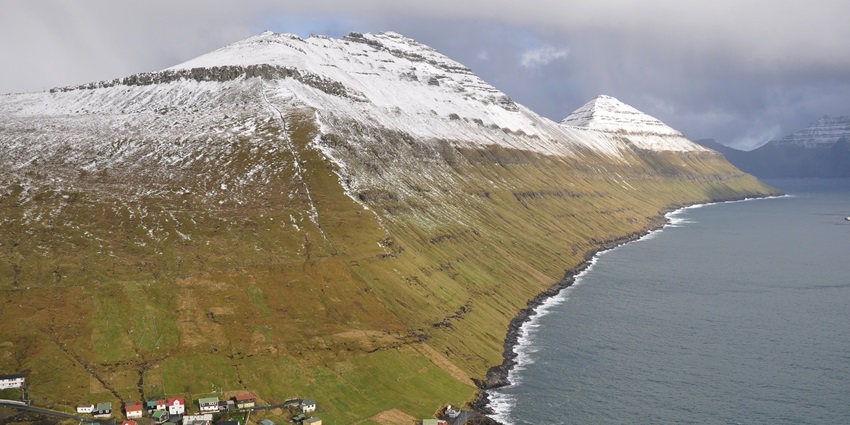
Photo: Vincent van Zeijst / Wikimedia Commons
The Faroe Islands are located in the North Atlantic Ocean, situated between Norway, Iceland, and Scotland. They lie approximately 320 km north-northwest of Scotland, 430 km southeast of Iceland, and 970 km west of Norway. Bridges, tunnels, and ferries connect the eighteen volcanic islands that make up the Faroe Islands, which span around 1,400 square kilometres. Tórshavn, the capital, is located on Streymoy, the largest island.
How To Reach
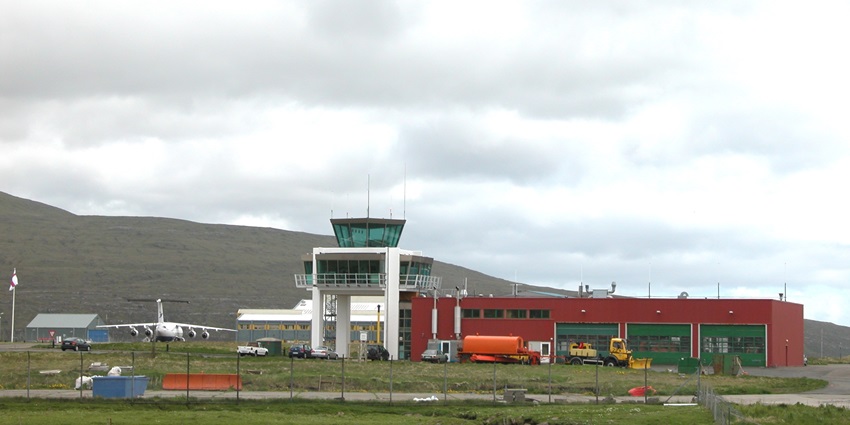
Photo: Erik Christensen / Wikimedia Commons
By Air: Vágar Airport (FAE) is the only airport in Faroe Islands. Atlantic Airways offers direct flights from Copenhagen, Edinburgh, Paris, and Reykjavik. Seasonal flights connect to other European cities.
By Train: No train services exist. The islands lack railway infrastructure.
By Road: There are no road connections to the mainland. Travel within the islands is by car, ferry, or helicopter.
Places To Visit On The Faroe Islands
Experience the best of Faroe Islands tourism with the top 3 must-visit places:
1. Sørvágsvatn
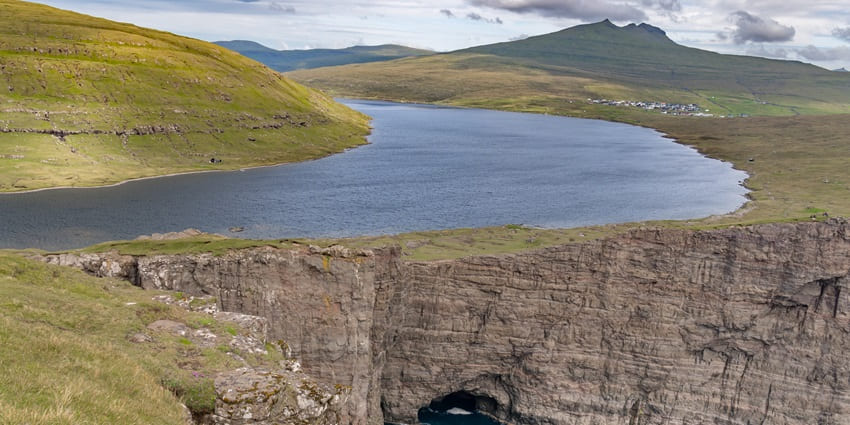
Photo: Ekrem Canli / Wikimedia Commons
Sørvágsvatn, also known as Leitisvatn, is the largest lake in Faroe Islands, covering approximately 3.4 square kilometres. Renowned for its optical illusion, when viewed from certain angles, the lake appears to float above the ocean, creating a mesmerising visual effect. The hike to the viewpoint is relatively easy, taking about 45 minutes to 1 hour. Visitors must check in at the landowners’ reception at the beginning of the trail and pay a hiking fee.
Mode Of Transport: Accessible by car or bus to the trailhead near Miðvágur, followed by a 3 – 4 kilometre hike to reach the scenic viewpoints.
Ideal For: Hikers, photographers, and nature enthusiasts seeking unique landscapes.
2. Múlafossur Waterfall
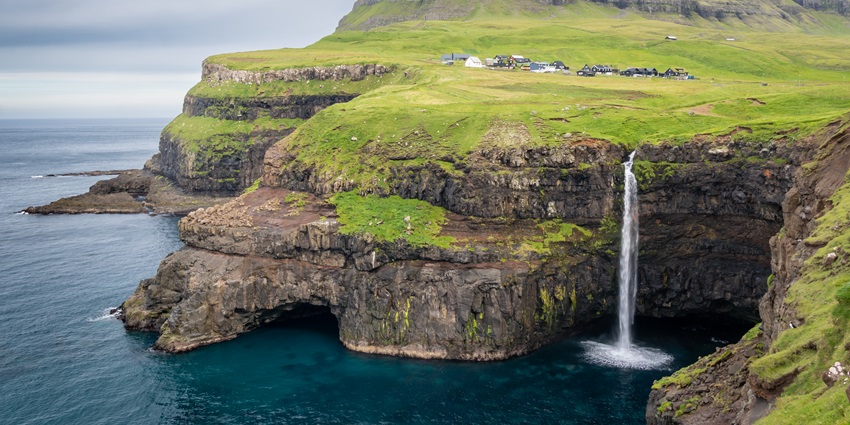
Photo: Ekrem Canli / Wikimedia Commons
Múlafossur is a picturesque waterfall near the village of Gásadalur, where water cascades over a cliff directly into the Atlantic Ocean. Its stunning beauty has made it one of Faroe Islands’ most photographed sites. The waterfall drops approximately 30 meters (100 feet) before meeting the sea. The village of Gásadalur, with its 13 inhabitants as of 2023, offers a glimpse into traditional Faroese life.
Mode Of Transport: Reachable by car or bus through a tunnel connecting Gásadalur to the rest of Vágar. A short walk from the village leads to the waterfall viewpoint.
Ideal For: Photographers, nature lovers, and those seeking tranquil scenery.
3. Mykines Island, The Birdwatcher’s Paradise
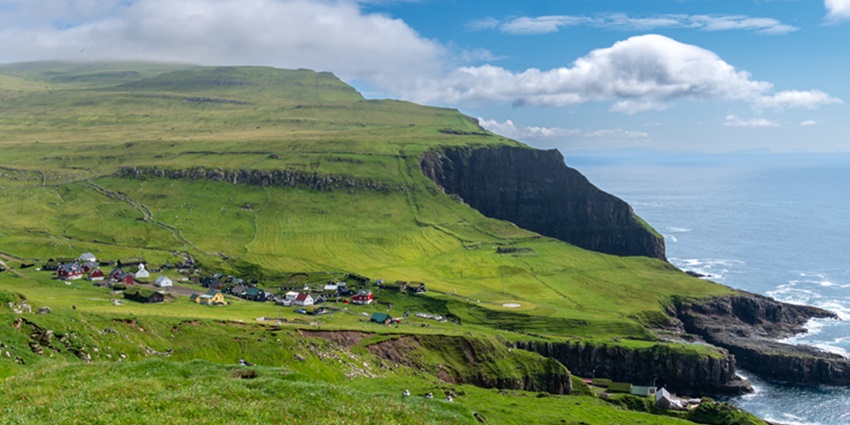
Photo: Ekrem Canli / Wikimedia Commons
Mykines is the westernmost island of Faroe, renowned for its rich birdlife, including puffin colonies and gannets. The island offers stunning landscapes, with green hills and dramatic cliffs. The hike to the Mykineshólmur lighthouse is popular among visitors, offering panoramic views of the Atlantic Ocean. The island has a small village with traditional turf-roofed houses, providing insight into Faroese culture.
Major Attractions: Birdwatching, The historic Mykineshólmur lighthouse
Mode Of Transport: Ferries operate from Sørvágur to Mykines during the summer months; helicopter services are also available. Note: Transport schedules can be affected by weather conditions.
Ideal For: Birdwatchers, hikers, and those seeking remote island experiences.
Must-Have Experiences On The Faroe Islands
Add the following activities to your itinerary and experience the best of the Faroe Islands:
1. Explore The Historic Tinganes In Tórshavn
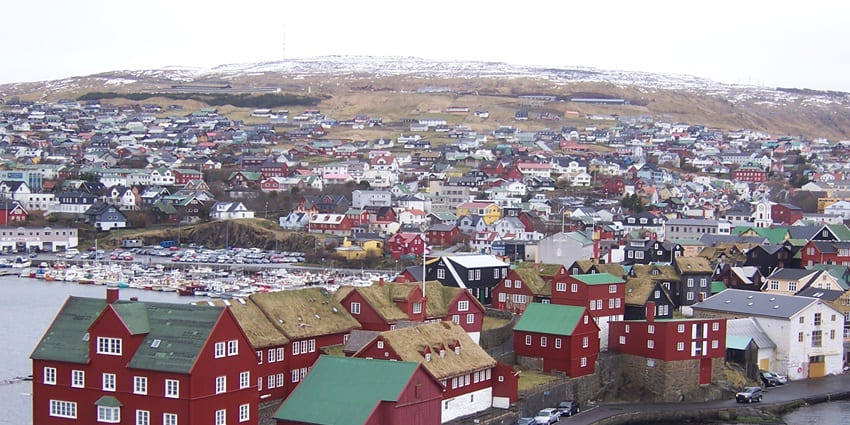
Photo: Madla~commonswiki / Wikimedia Commons
Tinganes, located in the capital city of Tórshavn, is one of the oldest parliamentary meeting places in the world. The area features traditional wooden buildings with characteristic grass roofs, reflecting classic Faroese architecture. Visitors can wander through narrow lanes, experiencing the blend of historical significance and local culture. The red-painted buildings, some dating back to the 16th century, now house government offices.
2. Hike To Kallur Lighthouse On Kalsoy Island
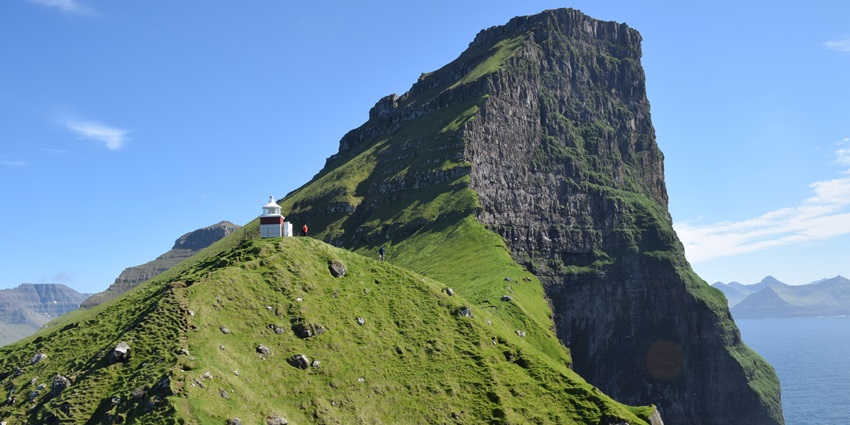
Photo: Maxdifra74 / Wikimedia Commons
The hike to Kallur Lighthouse offers breathtaking panoramic views of the surrounding islands and dramatic cliffs. The trail is moderately challenging, taking approximately 2 hours round trip. Along the way, hikers may encounter local wildlife and enjoy the island’s serene landscapes. The lighthouse itself stands as a picturesque landmark against the backdrop of the North Atlantic Ocean. This experience combines adventure with the opportunity to immerse oneself in the natural beauty of the Faroe Islands.
3. Admire The Vestmanna Sea Cliffs

Photo: Erik Christensen / Wikimedia Commons
The Vestmanna Sea Cliffs, located on the west coast of Streymoy Island, are among the Faroe Islands’ most visited natural attractions. Towering hundreds of meters above the ocean, these cliffs are home to numerous bird species, making it a paradise for birdwatchers. Boat tours navigate through narrow straits, beneath towering cliffs, and into deep grottoes, offering an intimate experience of this dramatic landscape.
Where To Stay
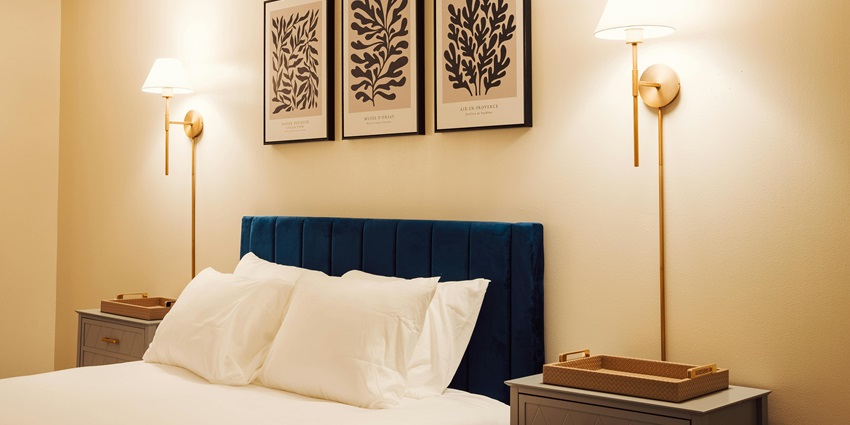
Photo: Raphael Loquellano / Pexels / Image For Representation Only
Accommodation options in the Faroe Islands cater to various preferences and budgets. Tórshavn, the capital, boasts several 4-star hotels, including Hotel Brandan and Hilton Garden Inn Faroe Islands, both opened in 2020. Other notable establishments are Hotel Føroyar, offering panoramic city views, and Hotel Hafnia, situated in the city centre. For more intimate settings, consider 62N Hotel City Centre, Havgrím Seaside Hotel, or Hotel Djurhuus.
Where To Eat
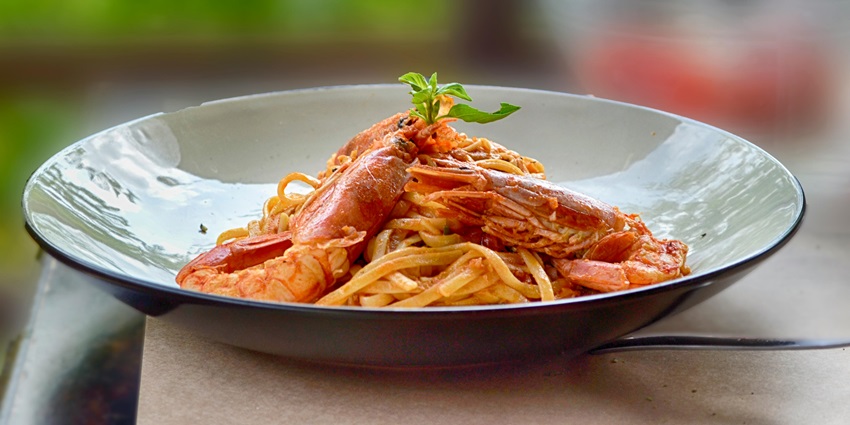
Photo: Dana Tentis / Pexels / Image For Representation Only
The Faroe Islands offer a diverse culinary scene that caters to various palates. In Tórshavn, Áarstova is renowned for its succulent braised lamb, reflecting traditional Faroese flavours. Barbara Fish House specialises in fresh seafood dishes, providing an authentic taste of the North Atlantic. For a unique experience, Ræst serves traditional fermented foods, offering insight into the island’s culinary heritage. Katrina Christiansen combines tapas with Faroese cuisine in a cosy setting.
Best Time To Visit
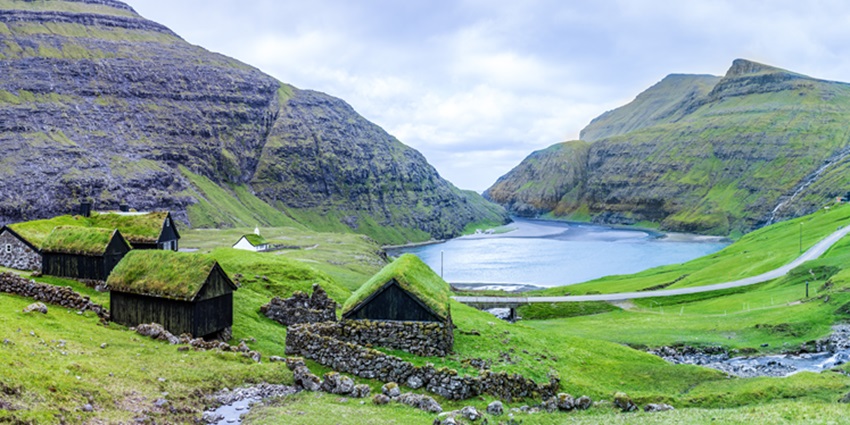
Photo: MiroRosa / Wikimedia Commons
The optimal time to visit the Faroe Islands largely depends on your interests. Faroe Islands weather during the summer months of June to August is mild and offers extended daylight and accessible tourist attractions. This period is ideal for outdoor activities such as hiking and birdwatching, especially observing puffins on Mykines Island. However, summer is also the peak tourist season, leading to higher prices and more visitors.
Other Factors To Consider
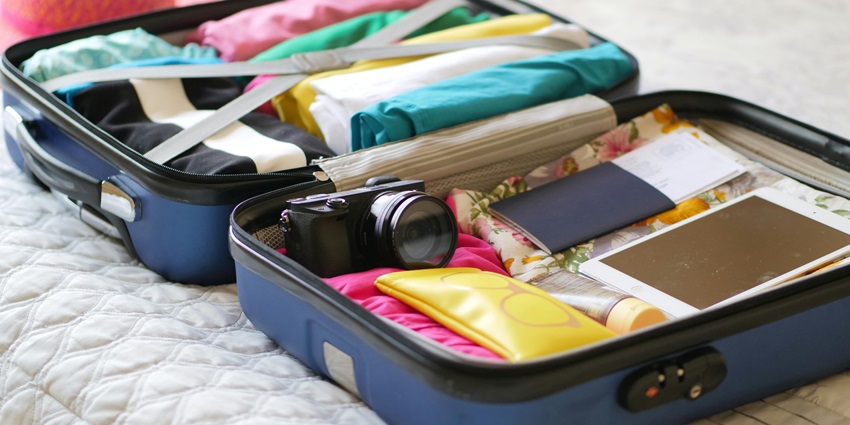
Photo: Kindel Media / Pexels / Image For Representation Only
Average Cost Of The Trip: The average cost of a trip to Faroe Islands is approximately ₹70,000 to ₹1,00,000 per person for a week. This includes flights (₹40,000-₹60,000), accommodations (about 1,500-2,500 DKK per night), meals (around 400-800 DKK per day), and activities. Costs can vary based on travel choices and the season, so planning ahead is advisable for accurate budgeting.
Tips For Travellers:
- Renting a car offers flexibility, but costs can be high.
- Public transport is available but may not reach all hiking spots.
- Limited lodging options mean booking well in advance is essential, especially during peak seasons.
- The climate is unpredictable; prepare for rapid changes and pack accordingly.
The Faroe Islands promise an unforgettable adventure with their dramatic landscapes, untouched wilderness, and rich culture. From towering sea cliffs and hidden waterfalls to charming villages and unique culinary experiences, every moment here feels magical. With ever-changing weather and breathtaking scenery, no two visits are the same. Plan wisely, embrace the unexpected, and immerse yourself in this Nordic paradise. Plan your next adventure today with TripXL.
Cover Photo: Eric Welch eric_welch / Wikimedia Commons


 WhatsApp
WhatsApp
 Twitter
Twitter









